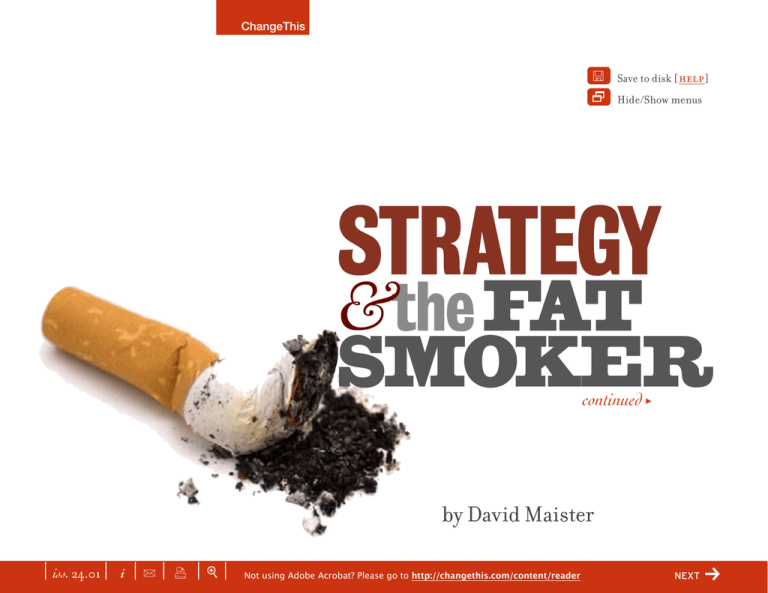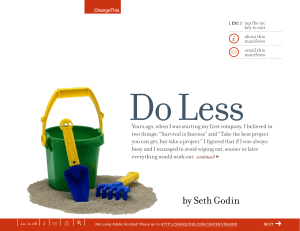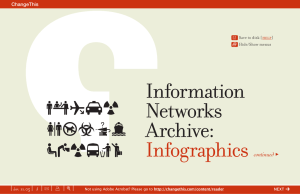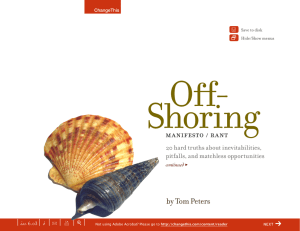
ChangeThis
Y
Save to disk [ help ]
2
Hide/Show menus
Strategy
&the Fat
Smoker
continued >
by David Maister
| iss. 24.01 | i | U |
x
|+|
Not using Adobe Acrobat? Please go to http://changethis.com/content/reader
next
f
ChangeThis
Much of what professional firms do in the name of strategic planning is a complete waste of
time, no more effective than individuals making New Year’s resolutions.
The reasons are the same in both situations. Personally and professionally, we already know
what we should do: lose weight, give up smoking, exercise more. In business, strategic plans
are also stuffed with familiar goals: build client relationships, act like team players, provide
fulfilling, motivating careers.
We want the benefits of these things. We know what to do, we know why we should do it and
we know how to do it. Yet we don’t change, most of us, as individuals or as businesses.
The problem is that many change efforts are based on the assumption that all you have to do
is to explain to people that their life could be better, be convincing that the goals are worth
going for and show them how to do it.
This is patently false. If this were true, there would be no drug addicts in the world, no alcoholics, no bad marriages: “Oh, I see, it’s not good for me? Ah, well then, I’ll stop, of course!”
What nonsense!
And yet strategic plans and annual speeches by CEOs, managing partners, management
consultants and others continue to have this same useless structure: “Look at how fabulous
it would be if you were a fit, non-smoking exerciser, David!” My usual response? “True, but
please shut up and go away.”
And that’s the response of most audiences to the manager’s or consultant’s latest vision or
strategy. “We knew all this a long time ago. Why don’t you ask us why we don’t do it?”
Now there’s an interesting question!
| iss. 24.01 | i | U |
x
|+|
h
/21
f
ChangeThis
Why We Don’t Do It
The primary reason we do not work at areas in which we know we need to improve is that the
rewards (and pleasures) are in the future; the disruption, discomfort and discipline needed to
get there are immediate.
To reach our goals, we must first change our lifestyle, our daily habits, now. Then we have to
have the courage to keep up the new habits and not yield to all the old familiar temptations.
Then, and only then, we get the benefits.
As human beings, we are not good at such decisions. We start self-improvement programs
with good intentions, but if they don’t pay off immediately, or if a temptation to depart from
the program arises, we abandon our efforts completely—until the next time we pretend to be
on the program.
That’s our pattern. Try a little, succumb to temptation, give up. Repeat until totally frustrated.
Unfortunately, there is rarely, if ever, a benefit from dabbling or trying a little of a new
strategy.
You can’t get half the benefits of a better marriage by cutting out half your affairs; you don’t
cure half the problems of alcoholism by cutting out half the drinks; and you don’t much
reduce the risks of lung cancer by cutting out half the cigarettes.
So it is with business strategy: you can’t achieve a competitive differentiation through things
you do “reasonably well, most of the time.” Not only can you not dabble, but you also cannot
have short-term strategies (an oxymoron, if ever there was one). The pursuit of short-term
goals is inherently anti-strategic and self-defeating.
| iss. 24.01 | i | U |
x
|+|
h
/21
f
ChangeThis
As Jean Nidetch (the founder of Weight Watchers) believed, the pursuit of quick weight loss
is always self-defeating and ill-advised. If you don’t understand from the beginning that you
have to change your lifestyle, now and forever, then you are wasting your time. Any initial
weight you lose will be put right back on.
What’s more, repeated, short-lived efforts at weight loss are actually detrimental to long-run
success since, among other reasons, they breed cynicism and the attitude of “We can’t do
this. We’ve tried and failed before.”
Millions of people and countless businesses have proved her insight exactly correct. You are
either seriously on the program, really living what you have chosen, or you are wasting your
time.
Strategy Is the Diet, Not the Goal
Debating which goals to pursue (whether you wish to choose losing weight, giving up smoking, ceasing to drink or starting to exercise) is a nonsensical process if you lack the discipline
to stick with the (different) diet and exercise programs that each of these requires. The only
meaningful debate is which diet you are really ready to get on.
Giving up smoking may be better for you (or a better competitive strategy), but if you’re
not willing to make the changes that that specific goal requires, its relative importance is
irrelevant.
It’s the same in business. Discussing “strengths, weaknesses, opportunities and threats” (to
take only the oldest and most familiar of the strategic planning exercises) is fun, but gets
nowhere near the real questions.
| iss. 24.01 | i | U |
x
|+|
Don’t agree with this manifesto? Write your own. Click here for details.
h
/21
f
ChangeThis
Improving the quality of the analysis is not where the problem lies. The necessary outcome of
strategic planning is not analytical insight but resolve.
The essential questions of strategy are these: “Which of our habits are we really prepared to
change, permanently and forever? Which lifestyle changes are we really prepared to make?
What issues are we really ready to tackle?”
Now that’s a different tone of conversation and discussion (and the reason the real debate
is so often avoided). Discussing goals is stimulating, inspiring and energizing. Discussing
what disciplines you are prepared to accept to get to a goal feels tough, awkward, annoying,
frightening and completely unpleasant.
An Illustration
As an example, consider the familiar strategic topic of aiming for competitive differentiation through excellence in client service. Here are three real-world examples of programs to
achieve this goal:
Once a quarter, an email is sent by the CEO to all active clients (without consultation with the
lead people serving those clients), asking them to click on one of three buttons in the email:
green if they are satisfied with the way their work is being handled, amber if they have some
concerns, and red if they are unhappy.
The CEO personally reviews all the email replies, every day, following up on every single one
that is not a green. Every quarter, the group averages on this score are published for each
operating unit within the firm (every office, every discipline area) and distributed to everyone
in the organization. Even the mail room clerks can see each quarter how well the senior vice
presidents in each group are doing on client satisfaction.
| iss. 24.01 | i | U |
x
|+|
h
/21
f
ChangeThis
At compensation-setting time, the relevant senior management group conducts a phone or
face-to-face interview with every client that partner has served in the last year (or a scientifically chosen random sample if the numbers are too high to be practical).
These client assessments carry a significant (40 to 60 percent) weighting in pay. You can’t
get paid for selling or doing more volume unless it is more volume of highly satisfied clients.
There is no reward for more volume of only moderately satisfied clients.
The organization adopts and publicizes an unconditional satisfaction guarantee, allowing
clients to pay only what they thought the work was worth if they were disappointed.
These are just three examples of how to enforce the same strategic idea. Other ideas may be
superior. The debate you would need to have in your firm, if you really want to pursue this or
any other strategic goal, would be a series of questions:
Which diet, if integrated into our normal running of the firm, would actually get us to perform
at a higher level, enough to achieve the benefits we seek?
Which would we be prepared to adopt as a central part of our regular lifestyle?
If we don’t like any of these diets, can anyone think of another that will have as much force as
these, but that we could live with more easily?
Substitutes are allowed. No one diet idea is without flaw, and there are drawbacks to every
program. If asked what the best way to lose weight is, the only sensible answer is: “Whatever
diet you will stick to!”
However, if there is no specific diet that all your people can agree to follow, then you must
conclude that you are not really willing or able to pursue that strategic goal.
| iss. 24.01 | i | U |
x
|+|
h
/21
f
ChangeThis
Which is no shame. Life offers many opportunities to do quite well being competent. You
don’t have to strive for excellence. It’s just that if you are not willing to do what it takes to
achieve excellence, you should probably just shut up about it (internally and externally) and
stop pretending!
There is no business benefit in claiming to pursue a goal that everyone can tell you don’t
have the guts to pursue. It not only makes you look foolish to clients, staff and colleagues,
but it also deeply demoralizes people and breeds cynicism. Declaring your commitment to
strategies that you don’t follow will lower your organization’s energy and its profits.
What Gets People on the Diet?
If all business improvement is like curing a fat smoker or helping an alcoholic recover, what,
then, actually gets people and organizations to change?
We all know the main thing that works: a major crisis! If revenues drop off sharply, it’s amazing how quickly businesses can act to deal with known inefficiencies and bad habits they
could have tackled years ago.
And when the first heart attack comes, it’s amazing how many people suddenly find the selfdiscipline to start living right.
That’s close to what happened to me. Until March 2005, I was a fat smoker. I had been overweight for most of my life and smoked a pack a day for 37 years. I don’t say that as a confession. I never pretended that getting fit was my strategy.
Then, a variety of medical conditions put me into the hospital with a kidney malfunction. In
the five months that followed, I stopped smoking, started exercising and lost 30 pounds.
| iss. 24.01 | i | U |
x
|+|
Want to copy and paste parts of this manifesto? Click here for instructions.
h
/21
f
ChangeThis
This was all wonderful news for me and an amazing and welcome surprise to my family and
friends, but a depressing conclusion for any theory of change.
Do people and institutions really have to wait until something very serious happens to them
to fix things they have known about for years? Isn’t there any hope of a better way?
We know only a few things about getting people to change before the heart attack comes,
but here are some.
1. It’s About a Permanent Change in Lifestyle
A major source of failure in implementing sensible business strategies is that we underestimate how much effort is truly required to bring about significant improvement.
A major reason that only a small proportion of those who try to implement strategic programs (or stick to diets) ever obtain the benefits they seek is that too many individuals and
businesses think of improvement (and strategy) as a distinct schedule of activities, separate
(and sometimes separately accounted for) from regular business activities. In other words,
there’s real life, and then there’s the diet.
Viewed that way, all improvement programs are doomed to failure. As I discuss in the
“Natural Manager” episode of my Masterclass on Business podcast series, my trainer Jerry
(Dyelry) Labbate points out that you don’t really get the sustained benefits of being an
exerciser until it has become as natural and permanent a part of your life as brushing your
teeth and taking a shower each day. Anything less than that will put in jeopardy any shortterm gains you might obtain with bursts of activity. It’s about routines, not special events.
| iss. 24.01 | i | U |
x
|+|
h
/21
f
ChangeThis
2. You Must Change the Core Scorecards
Strategy, if is to be lived and achieved, is about modifying the very rules of daily living and
scorekeeping. You must scheme carefully about how new tracking measures of the strategies you pursue are published and disseminated.
If you are trying to lose weight, you must get on the scale regularly. If you do not, it is too
easy to let yourself go and fool yourself as to how you are doing. But if you are the only
one to see what the measurement says, the force for change will be minimal.
We all forgive ourselves too easily. We all find it quite easy to live with guilt. Even high levels of guilt don’t change people. Embarrassment, even in small doses, is far more effective.
How much more forceful it would be if you let your spouse see, each time, what you weigh!
Or better yet, what about letting your children monitor your progress?
So it is in professional life. When I was a teacher at the Harvard Business School, every
course taught there was evaluated by the students at the end of every semester, and the
results were published to everyone on campus. There was no doubt at that institution as to
what the strategy was!
3. Leadership: Get Serious, or Get Out of the Way
Organizations often rush to figure out how the troops need to change to live the new
standards. However, this is not the first task. Perhaps the single biggest difficulty in getting
an organization to stick to the diet is convincing them that top management really wants
them to.
For example, if a group within the firm faces a trade-off between a lesser volume of highquality work and a greater volume of “acceptable-quality” work, it is critical that they
| iss. 24.01 | i | U |
x
|+|
h
/21
f
ChangeThis
understand without ambiguity what choice firm leaders wish them to make. If they believe
that management, when push comes to shove, wants the second alternative, they will never
stretch to engage in strategic behaviors themselves.
If the leadership of the organization wants the people in it to believe that a new strategy is
being followed, they must figure out a way for it to be credible that they, top management,
have actually changed their thinking and are prepared to change the way they act, measure
and reward.
I have countless examples of failure to do this. I was asked by one firm to run a program
for their middle managers on how to be more effective as managers, but my instructions
included this: “Please don’t raise the topic of how well we ourselves manage these middle
managers. We know we do that terribly, but we’re not ready to discuss that. Keep their attention on what they could do better. We want them to change first.”
Can you imaging a process less likely to get the people in the organization to actually live
to higher standards?
A similar event happened when I was asked to moderate a discussion in a firm that wanted
the people in its different regions to work for the good of the institution, not just their own
region. Unfortunately, as I ran this discussion, the CEO at the back of the room became
more and more agitated.
I later found out that he had turned to his second in command and said, “This guy keeps
talking about what we in management need to change to become a one-firm firm. We
wanted him to talk about what the people out in the field need to do.” Not surprisingly,
they never achieved collaboration, and I was never invited back to that firm!
This illustrates, by the way, the fatal flaw in using all outside speakers and consultants.
Whether or not they are convincing, educational or inspirational, the question on the
| iss. 24.01 | i | U |
x
|+|
Want to find the most buzzworthy manifestos? discover them here.
h
10/21
f
ChangeThis
audience’s mind is, “Do our leaders believe this and are they actually going to run the firm
that way?”
All too often, the audience is given no evidence of the firm’s leadership commitment to the
ideas, and the whole exercise becomes a waste of money and time. I have been told more
times than I care to remember that the reaction to one of my presentations has been, “This
all makes terrific sense, but there’s no way we’ll ever do these things around here.”
If people are to make the right strategic decision in every location of the firm, in every operating group and at every level, then they must absolutely trust that management will back
them up and reward them (or at least not punish them) for acting in accordance with the
declared strategy. A large part of really bringing about strategic change is designing some
action or new system that visibly, inescapably and irreversibly commits top management to
the strategy.
I have sometimes asked firm leaders whether they are willing to announce to their people,
right up front, that they will resign their roles if measurable progress is not made on the
strategic plans they advocate. Such a commitment has had a dramatic impact where it has
been made.
4. Principles Are More Effective Than Tactics
Since successful implementation of a strategy requires both sustained commitment over
time and broad participation across the whole organization, strategies in business, like
diets and alcohol recovery, are implemented much better when the ideas are presented as
matters of principle, not just as matters of expediency.
| iss. 24.01 | i | U |
x
|+|
h
11/21
f
ChangeThis
If strategic rules are justified only in terms of outcomes (“exercise daily in order to look
good”), the diet will always be seen as a punishment on the way to an uncertain and possibly unattainable reward. Accordingly, it will always be resented.
If, however, diet achieves the force of moral principle (such as “treating clients and employees with respect is a value around here, not just a tactic”), the odds are significantly higher
that successful implementation will be achieved.
As I reported in True Professionalism and Practice What You Preach, managers who get
things done are people who are seen to have an ideology—their people believe that they
believe in something.
This is because buy-in and excellent implementation result from a sense of not wanting to
let people down. My physical trainer reports that some of his clients tell him that they keep
up their exercise programs between meetings because they “don’t want to disappoint him.”
5. People Must Volunteer
Even though it is the leader’s job to offer an ideology around which people can rally, it is by
itself only a necessary, but not sufficient, first step.
Among the most powerful revelations of any successful recovery or self-improvement
program, perhaps the most important is this: it only works when the individual is doing it
for himself or herself and has made a personal choice to do it.
It doesn’t work if the person is doing it only for their spouse, or for his or her children, or
to gain the good opinion of others. To sustain the effort, an individual has got to make a
personal choice that the change is being made for him- or herself.
| iss. 24.01 | i | U |
x
|+|
h
12/21
f
ChangeThis
The motivation must be intrinsic. Since the essence of successful strategic change is not
technique, but will. If you prefer, you can call it determination, commitment or resolve.
To achieve any goal, you must really want the goal. The common questions presented when
discussing strategies and strategic change are these: “Do we have to do this? Why, when
things are going so well, do we need to accept more discipline into our lives?”
The answer, of course, is that you don’t have to do anything you don’t want to do. Strategy
in a professional business is a choice that each individual has to make about whether he or
she wants to put more effort into his or her life and career in order to get somewhere new.
In professional firms, it is dangerous to assume that every person, or every partner, does.
That’s why most firms (and most individuals) don’t pull off their strategies: not everyone
in the firm actually wants to try that hard. They will say they want to be the clear market
leader in their field; they are just not willing to do what that takes.
It’s valid for them to make this choice. After all, I was a fat smoker for 37 years and felt
I had the right to remain so. For me and for others, the single biggest barrier to making
change is the feeling that “it’s OK so far.” People don’t disagree that the future state of being a non-smoker would be beneficial, but they resist when they are told that they have to
do it.
Brad Robitaille, a Canadian lawyer, points out that while execution of a strategic plan is
hard work, it must be hard work that a person loves to do, because only passion creates
the determination to continue. He also notes that “no one can instill passion in anyone
else’s heart.” It must come from within. If the hard work inherent in executing the disciplines of strategy is merely a by-product of duty and obligation, then the battle is lost
before it has even begun.
| iss. 24.01 | i | U |
x
|+|
Be bold. Dream up your own manifesto and submit your idea here.
h
13/21
f
ChangeThis
One of a leader’s roles is to act as a coach, drawing people’s attention to what is not perfect about the status quo (i.e., creating dissatisfaction), whether things could actually be
better, and whether the desired change is both achievable and desirable. But it’s subtle
stuff—the leader must be skilled in not only knowing the answers to these questions, but
also in the process of helping others think it through to a personal conclusion.
6. People Must Get On or Off the Bus
Every individual can, and must, make a personal choice. But then the organization must
decide how to respond to those individual choices. For an organization, strategy cannot be
what “most of us, most of the time” do. You’ll never be good enough as a firm if participation in your firm’s definition of excellence is optional.
If a number of top people have clearly not signed up for the journey or are clearly not true
believers, no number of systems or amount of inspired speech making will get the organization there. Strategy making in professional firms is as often about getting some senior
people to leave as it is about bringing new people in.
Jim Collins in Good to Great called this “getting the right people on and off the bus” and
identified it as the first step in all programs for strategic greatness.
Everyone in the organization has to decide if they want to try hard enough to sacrifice some
of the present to achieve a better tomorrow. They may do so if they believe the effort is
serious. They definitely will not if they think those at the top are undecided or are divided.
Professional firms are afraid of this conclusion. They try to work around the skeptics, the
non-believers and the non-participants in their senior ranks, preferring to hold on to
revenue volume rather than achieve a senior team who all want to go to the same place and
have the same resolve to get there. That’s fine, but you can’t call it strategy.
| iss. 24.01 | i | U |
x
|+|
h 14/21 f
ChangeThis
As all married couples who try dieting know, it’s hard enough to stay the course and resist
temptation when you are both attempting to do the right thing. It’s nigh impossible if those
around you continue to indulge and there are temptations (food, alcohol, etc.) all around. You
either pull this off together, or you will lose the resolve and you will fail.
Notice, it’s absolutely not about how we can force people to do what we want. It’s about how
we can make sure that people have opted in and that those who do not wish to be on the
program have opted out—of the firm!
People absolutely need the mutual support (and social structure) that comes from doing this
together, in common cause. People need to help each other through the tough times (“Come
on, one last repetition of the training circuit”) instead of being part of a forgiving culture that
keeps discouraging extra effort. (“Oh, that’s OK, you can skip exercise today. You deserve a
break.”)
Again, that’s why other researchers and I keep discovering that the most successful organizations have an ideology. There is a McKinsey way, a Goldman Sachs approach and a Bain
philosophy, to take only three examples of firms with strong ideologies, clear strategies and
the financial success to match.
At these firms, if you don’t subscribe to the ideology, you don’t stay and argue or act as a
silent dissenter. You walk. Or, eventually, you’re asked to walk.
| iss. 24.01 | i | U |
x
|+|
h
15/21
f
ChangeThis
Managing the Process of Change
None of this is meant to say that firms must change overnight. It truly is, like alcoholic recovery, a process of “first make a lifetime commitment, then take it one day at time.”
Once we know what the agreed-upon diet is, there is a need for skilled coaching in leading
individuals and teams through the struggle to attain the goals they have committed to.
I have described this process elsewhere: my article “A Great Coach in Action” and my book,
First Among Equals, both explore this topic in depth. But it is worth reviewing the highlights
of what we know about diet and exercise program management here.
The key is to manage with a philosophy of “It’s OK to stumble; it’s only a sin if you don’t get
back on the program.” The primary goal of the beginning stage of a change program is to get
people to believe that it is doable and that all we are asking is that they try. This means early
successes.
All that wise leaders (and good trainers) talk about is the next small step. And they celebrate
like crazy each small accomplishment. They focus on requiring improvement, not on requiring excellence. “As long as you are improving, you’re with the program, and one of us!”
Managing a weight loss program often means you stop talking about the ultimate goal. If you
keep reminding me that I need to lose 50 pounds, it is as likely to backfire and make me give
up as it is to energize me.
But what if someone says to me, “Let’s just focus on losing one pound in a week, David. Do
you think you can do that? That doesn’t sound impossible, does it?” My reaction to that will
be a lot different. Yet, of course, one pound a week is 50 pounds in a year. An alcoholic is
daunted by a lifetime of abstinence, but he or she can manage to not drink just for today.
| iss. 24.01 | i | U |
x
|+|
h
16/21
f
ChangeThis
Michael Webb, a sales consultant, points out that short-term goals (“Lose a pound a week”)
only take on value in the context of principles, which are long-term. First, one establishes
what is important; then, you get people to do a little of it, a little more and so on. It is commitment to a process of continuous improvement on things that matter.
In my article “The Courage to Have a Strategy,” I described this as an attitude of “Rome wasn’t
built in a day, but we are building Rome.” It can be described as a managerial style of insistent patience.
Encouragement is an essential ingredient in the recipe. When I began exercising, it was sobering to realize how much I needed my trainer’s words (“Good, good, David”) when I had
just been able to complete an exercise for the first time.
At one level, I knew I was pathetically bad, but it really did help to hear his constant encouragement: “You’re doing much better, David. You might not be able to feel it, but as a trainer I
can see it.”
I don’t know how much of it was him being falsely optimistic, and I am sure it was all a wellpracticed mind game.
But, as every good trainer knows, that’s the point. We all need to play mind games with
ourselves when we struggle to build new achievements and habits into our lives. (“If I can just
finish this first one, I’ll reward myself with a break. Let me just get this first one done!”)
It also means making a game of strategic programs. Educated professionals may scoff, but
it’s profoundly rooted in the human psyche that if you can make a game of something, it
helps to sustain strenuous effort.
Hence all the hoopla of various strategic initiatives such as “Six Sigma,” “quality is free” and
similar fads; business jargon; and prizes, rewards and “black belt” recognition programs.
| iss. 24.01 | i | U |
x
|+|
Every one of our manifestos is free. See the rest of them.
h
17/21
f
ChangeThis
There’s a reason such things work, even among cynical people. They help to make a “mind
game” of the whole thing, creating a framework on which we hang the mind-distracting habits. (“If I can just do this one thing, I can make it. If I change the way I do that, I will be better
able to stick to things.)
Good trainers know that life-changing improvement can and does fail by rushing to either of
the two extremes: establishing improvement goals that are too ambitious or take too long to
achieve, thus leading to frustration and abandonment of the program, or failing to establish
any pressure to improve, allowing people to pretend that they plan to get on the program,
but just not today.
The good news in all of this is that, in the world at large, there is experience in helping people make significant improvement in their lives. There are well-documented methodologies;
they are just not the ones we usually associate with the business world.
If we are prepared to rethink how we view strategy and business life, then people can achieve
things they never thought possible. If I can become a fit, non-smoking exerciser, there’s truly
no limit!
Copyright © David Maister
| iss. 24.01 | i | U |
x
|+|
h
18/21
f
ChangeThis
info
About the Author
David Maister is widely acknowledged as one of the world’s leading authorities on the management
of professional service firms. For two decades he has acted as a consultant to prominent professional
firms around the world, on a wide variety of strategic and managerial issues. In 2002, he was named
as one of the top 40 business thinkers in the world (Business Minds, by Tom Brown, PrenticeHall/
Financial Times). He is the author of the bestselling books Managing the Professional Service Firm (1993),
True Professionalism (1997), The Trusted Advisor (2000), Practice What You Preach (2001) and First Among
Equals (2002). These books have been translated into 14 languages. For seven years, he served as a
professor on the faculty of the Harvard Business School (1979-85), prior to launching his consulting
practice. He lives in Boston, Massachusetts.
In March of 2005, he finally took his own advice, gave up smoking and lost 30 pounds.
Visit his website at www.davidmaister.com
download this
This manifesto is available from http://changethis.com/24.StrategyFatSmoker
send this Click here to pass along a copy of this manifesto to others.
http://changethis.com/24.StrategyFatSmoker/email
Subscribe
Learn about our latest manifestos as soon as they are available. Sign up for our free newsletter and
be notified by email. http://changethis.com/subscribe
z
| iss. 24.01 | i | U |
x
|+|
last page read
h
| more
19/21
f
f
ChangeThis
info
WHAT YOU CAN DO
You are given the unlimited right to print this manifesto and to distribute it electronically (via email,
your website, or any other means). You can print out pages and put them in your favorite coffee shop’s
windows or your doctor’s waiting room. You can transcribe the author’s words onto the sidewalk, or
you can hand out copies to everyone you meet. You may not alter this manifesto in any way, though,
and you may not charge for it.
Navigation & User Tips Move around this manifesto by using your keyboard arrow keys or click on the right arrow ( f ) for
the next page and the left arrow ( h ). To send this by email, just click on
U
.
Having problems saving to disk? First, make sure you have the latest version of Acrobat Reader 6 which you can download from
http://www.adobe.com/products/acrobat/readstep2.html. If problems persist, it may be due to your
Acrobat Reader settings. To correct the problem (for Windows), a reader, J. Hansen, suggests going
to your Acrobat Reader Preferences > Options > Web browser Options. Check the “Display PDF in
Browser” option. Then click on Save to Disk
Y
.
keyboard shortcuts
pcmac
Zoom in (Larger view)
[ ctl ] [ + ] Full screen/Normal screen view
[ ctl ] [ L ] Zoom out
[
#]
[#]
[#]
[ ctl ] [ - ] z
| iss. 24.01 | i | U |
x
|+|
[+]
[-]
[L]
last page read
| more
f
h 20/21 f
ChangeThis
info
Born on date
This document was created on 3 July 2006 and is based on the best information available at that
time. To check for updates, please click here to visit http://changethis.com/24.StrategyFatSmoker
Copyright info
some rights reserved
cc creative
commons
The copyright in this work belongs to the author, who is solely responsible for the content. Please
direct content feedback or permissions questions to the author: david@davidmaister.com
This work is licensed under the Creative Commons Attribution-NonCommercial-NoDerivs License.
To view a copy of this license, visit http://creativecommons.org/licenses/by-nc-nd/2.5 or send a
letter to Creative Commons, 559 Nathan Abbott Way, Stanford, California 94305, USA.
Cover image from http://istockphoto.com
ABOUT CHANGETHIS
ChangeThis is a vehicle, not a publisher. We make it easy for big ideas to spread. While the authors
we work with are responsible for their own work, they don’t necessarily agree with everything
available in ChangeThis format. But you knew that already.
ChangeThis is supported by the love and tender care of 800-CEO-READ. Visit us at main site
www.800ceoread.com or at our daily blog blog.800ceoread.com.
z
| iss. 24.01 | i | U |
x
|+|
last page read
h
21/21








